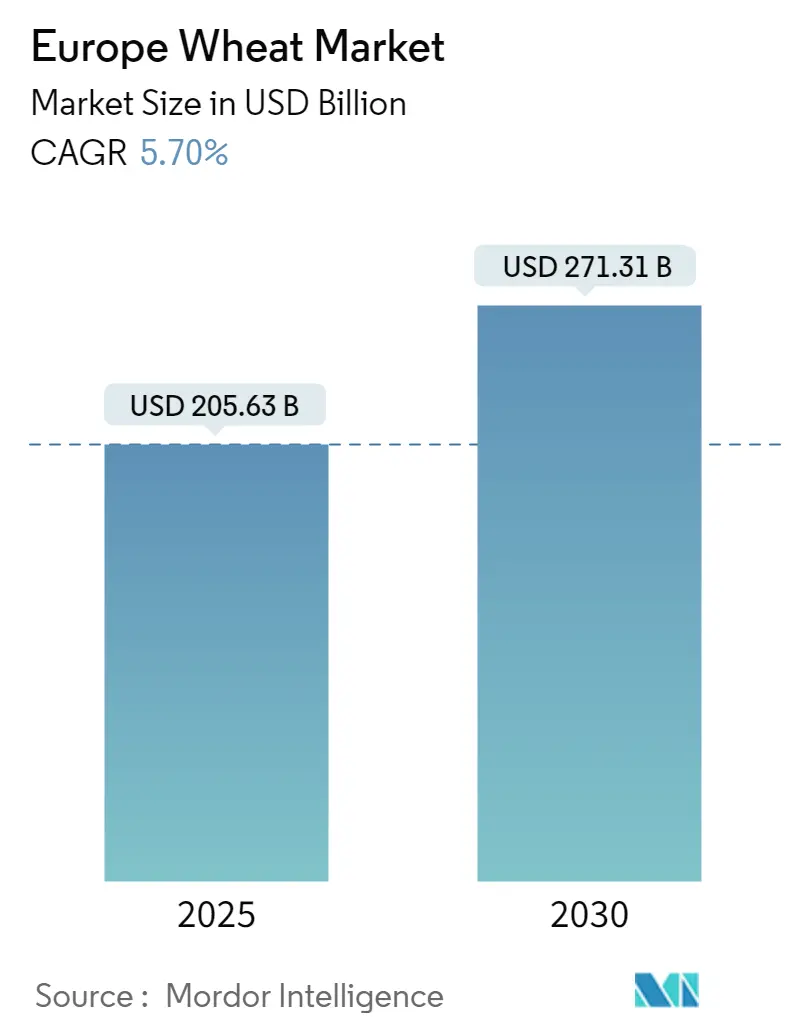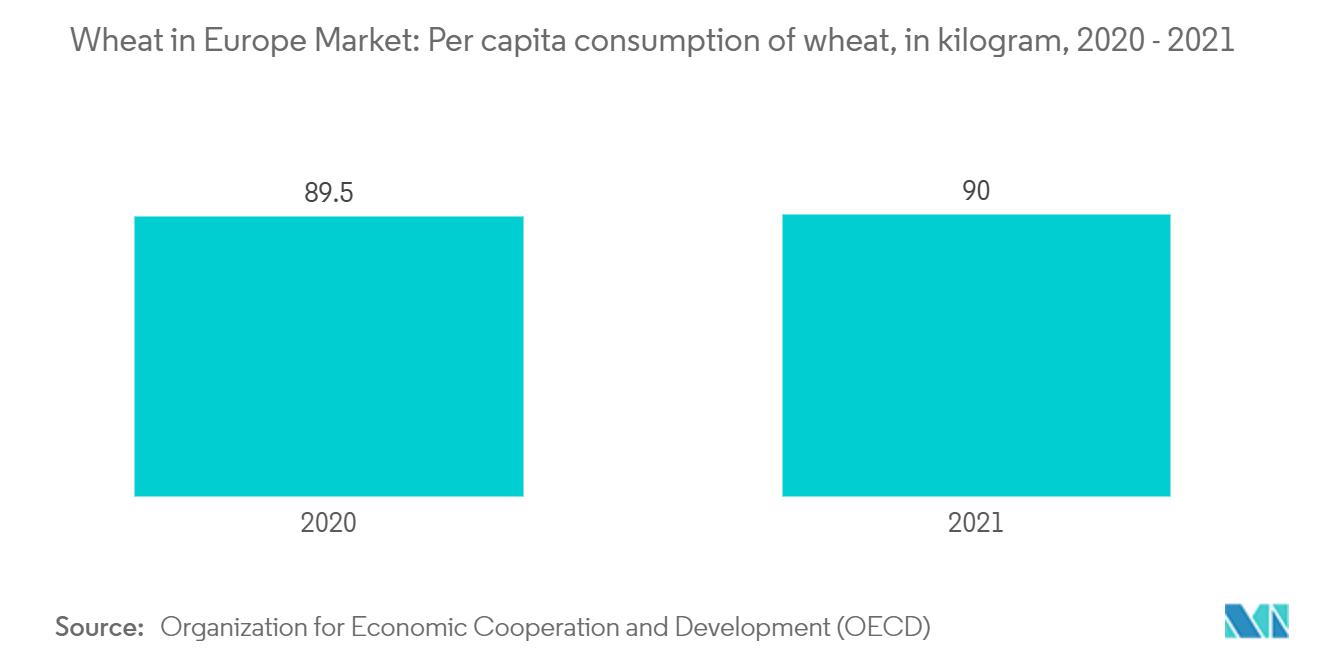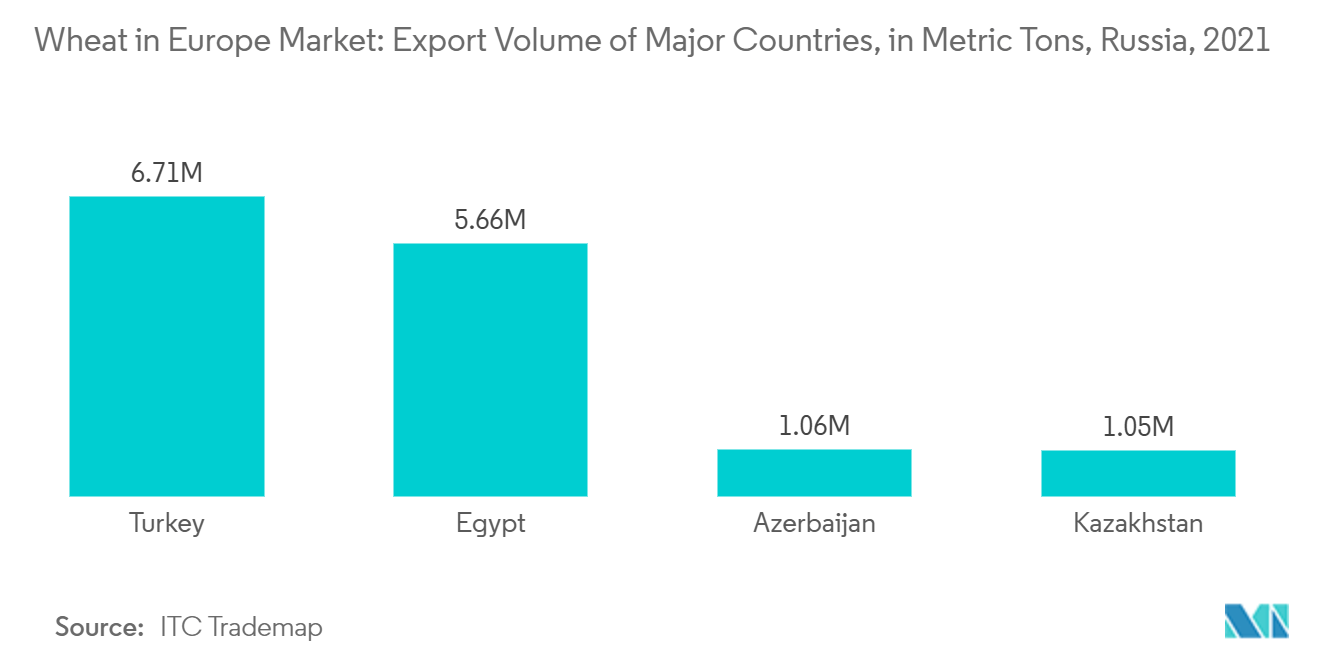
Europe Wheat Market Analysis by Mordor Intelligence
The Europe Wheat Market size is estimated at USD 205.63 billion in 2025, and is expected to reach USD 271.31 billion by 2030, at a CAGR of 5.7% during the forecast period (2025-2030).
Europe emerged as the world's leading wheat producer, contributing 282.7 million metric tons, as reported by the FAO during the year 2022. Eurostat data highlights France as the European Union's foremost wheat producer, with a yield of 34.6 million tons in 2022. Germany followed with a production of 22.7 million tons, while Poland contributed 13.2 million tons. Spain and Italy share the fifth spot among the European Union's top producers. Notably, wheat constitutes over half of the cereals grown in the region. The rising demand for wheat and wheat flour is largely attributed to a growing consumer preference for processed and convenience foods. Wheat flour plays a crucial role in enhancing the texture and profile of various convenience food items, including bakery products, snacks, and ready-to-eat meals. As the food & beverages industry expands and economic conditions improve, there's a noticeable shift towards convenience foods among consumers in both developed and developing European nations, driving the market's growth.
In recent years, there's been a marked increase in the region's consumption of ready-to-eat food and beverages, further fueling the demand for convenience foods. For example, data from the Office for National Statistics (UK) reveals that in 2022, sales of prepared meals and dishes surged to approximately GBP 3.82 billion (USD 4.71 billion), up from GBP 3.51 billion (USD 4.50 billion) in 2020. This rising demand for convenience food items is set to drive the need for wheat and wheat flour. Across Europe, convenience foods are increasingly catering to the surging food demand.
In 2022, European wheat prices were buoyed by renewed demand and bargain buying, especially in the absence of US market influences. Traders, however, remained skeptical of Russia's move to reduce its grain export tax, aiming to make its wheat more competitive globally. In response to the surging demands, companies are focusing on enhancing grain quality and optimizing distribution channels to cater to a wider customer base.
Europe Wheat Market Trends and Insights
Rising Demand for Wheat-Based Products
Wheat serves as a staple cereal crop across Europe, with Malta, Italy, and Romania leading in consumption. As urbanization reshapes lifestyles, there's a noticeable shift towards convenience foods, such as bread and confectioneries. This evolving preference, emphasizing nature, convenience, and indulgence, has resulted in reduced time for home food preparation, further boosting wheat consumption.
Wheat is a primary ingredient in various bakery and food products, with its usage being particularly pronounced in Europe. Many Europeans consume bread or wheat-based meals daily. Beyond this, wheat's gluten content acts as a natural binder, making it ideal for baked goods and processed meats. Eurostat data reveals that in 2023, the European Union ranked second globally in wheat consumption, trailing only China, with a consumption of 110,000 thousand metric tons. This uptick in wheat-based food production directly correlates with heightened wheat consumption in the region.
Moreover, Europe's growing self-sufficiency in wheat production further fuels its consumption. OECD data highlights a rise in per capita wheat consumption in Europe, from 89.5 kg in 2020 to 90.04 kg in 2021. This surge aligns with an increase in harvested wheat areas, growing from 70.1 in 2020 to 71.2 in 2021. As more land is dedicated to wheat cultivation, production rises, subsequently driving up per capita wheat consumption and propelling market growth during the forecast period.

Russia Dominates Wheat Exports in the Region
In 2022, Russia emerged as the leading wheat producer in the region, generating approximately 104.2 million metric tons of grain, marking a 37% surge from the previous year. On the global stage, Russia ranks third in wheat production, trailing only behind China and India. The harvested area for wheat expanded from 27.9 million hectares in 2021 to 29.3 million hectares in 2022. Southern Russia's black soil region, renowned as one of the world's premier agricultural lands, primarily cultivates wheat as a winter crop.
USDA data indicates that in 2021, Russia's wheat consumption reached 41,750 thousand metric tons. As a staple food, wheat consumption in Russia is projected to rise. However, given wheat's sensitivity to weather, its production remains vulnerable to climate change. Yet, with vast untapped land resources and notable yield gaps, Russia is poised for a significant boost in wheat production. Nonetheless, the warming climate and extreme temperatures pose threats, potentially jeopardizing global food security for key crops like wheat.
USDA reports confirm Russia's status as the world's top wheat exporter, holding a 16.5% share of the global wheat export market in the 2023 marketing year. ITC Trade Map data reveals that in 2023, Russia's wheat exports were valued at a substantial USD 9,821.4 million. Major importers of Russian wheat in 2021 included Turkey, Egypt, Azerbaijan, and Nigeria, accounting for 24.7%, 21.2%, 4%, and 3% of imports, respectively. Notably, Egypt, the world's largest wheat importer, consistently turns to Russian and Ukrainian wheat to satisfy its domestic needs. With its leading position in both production and exports, Russia firmly establishes its dominance in the global wheat market.

Recent Industry Developments
- December 2023: Scientists in Germany have successfully developed a wheat variety capable of multiple harvests within a single year. Reports from Deutsche Welle, a prominent German news outlet, highlight that this newly engineered wheat matures at an accelerated pace, allowing for an impressive yield of up to six times annually.
- July 2022: RAGT Seed Group has developed two new hard-milling feed winter wheat varieties, claiming resistance to barley yellow dwarf virus (BYDV) and the orange wheat blossom midge.
Europe Wheat Market Report Scope
Wheat is a grass widely cultivated for its seed, a cereal grain that is a worldwide staple food and is ground to make flour for bread, pasta, pastry, etc. The Europe Wheat Market is segmented by Geography into Spain, France, United Kingdom, Germany, and Russia. The report includes production (volume), consumption (volume and value), import (volume and value), export (volume and value), and price trend analyses. The report offers market estimation and forecasts value in (USD) and volume (metric tons) for the above segments.
| Spain |
| France |
| United Kingdom |
| Germany |
| Russia |
| Geography (Production Analysis in Volume, Consumption Analysis by Volume and Value, Import Analysis by Value and Volume, Export Analysis by Value and Volume, and Price Trend Analysis) | Spain |
| France | |
| United Kingdom | |
| Germany | |
| Russia |
Key Questions Answered in the Report
How big is the Europe Wheat Market?
The Europe Wheat Market size is expected to reach USD 205.63 billion in 2025 and grow at a CAGR of 5.70% to reach USD 271.31 billion by 2030.
What is the current Europe Wheat Market size?
In 2025, the Europe Wheat Market size is expected to reach USD 205.63 billion.
What years does this Europe Wheat Market cover, and what was the market size in 2024?
In 2024, the Europe Wheat Market size was estimated at USD 193.91 billion. The report covers the Europe Wheat Market historical market size for years: 2019, 2020, 2021, 2022, 2023 and 2024. The report also forecasts the Europe Wheat Market size for years: 2025, 2026, 2027, 2028, 2029 and 2030.
Page last updated on:
Europe Wheat Market Report
Statistics for the 2025 Europe Wheat market share, size and revenue growth rate, created by Mordor Intelligence™ Industry Reports. Europe Wheat analysis includes a market forecast outlook for 2025 to 2030 and historical overview. Get a sample of this industry analysis as a free report PDF download.

